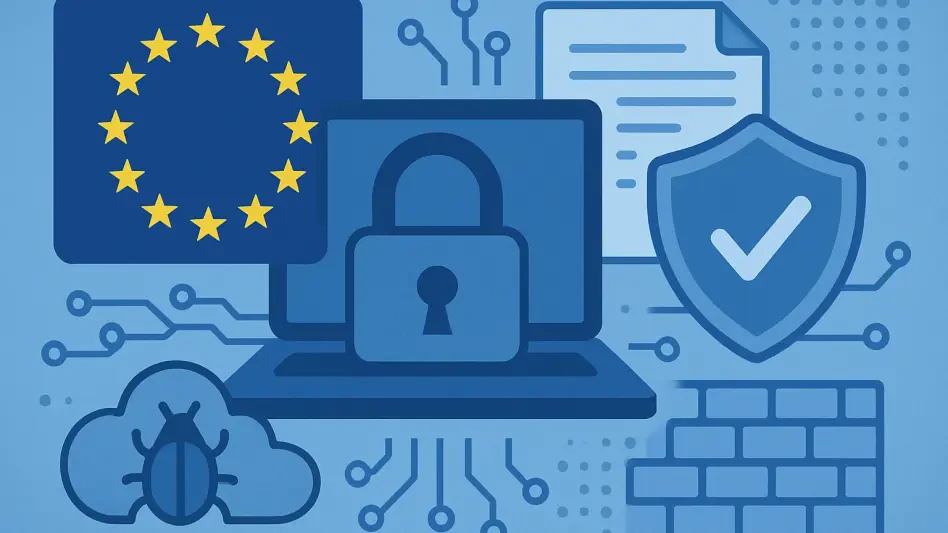In an era where cyber threats loom larger than ever, the European Union (EU) has taken a bold stand with the introduction of the Cyber Resilience Act (CRA), a groundbreaking piece of legislation designed to fortify digital security across its 27 member states. This act is not a standalone measure but part of a comprehensive framework of six mandatory regulations, including the General Data Protection Regulation (GDPR) and the Digital Operational Resilience Act (DORA), all aimed at embedding a “secure-by-design” ethos into the digital landscape. The EU’s approach raises a compelling question about whether this intricate web of rules positions it as the most tightly controlled cyber market on the global stage. Unlike other regions with fragmented or voluntary guidelines, the EU seeks to create a unified shield against cyber risks, impacting businesses, governments, and consumers alike. This ambitious regulatory push sets the stage for a deeper exploration of its implications, challenges, and potential to redefine global cybersecurity standards.
EU’s Unique Position in Global Cybersecurity
A Harmonized Regulatory Framework
The EU distinguishes itself in the global cybersecurity arena through a meticulously integrated set of regulations that apply uniformly across its diverse member states. This harmonized framework, encompassing laws like the CRA and initiatives such as the Cyber Solidarity Act (CSA), eliminates the patchwork of rules often seen in other regions like the United States, where policies can differ significantly by state or industry. Supported by entities like the European Cybersecurity Competence Centre (ECCC) in Romania, the EU aims to forge a consistent digital ecosystem that prioritizes security at every level. This unified strategy not only streamlines compliance for businesses operating across borders but also seeks to establish a benchmark that other markets might follow. The depth and breadth of these regulations suggest a level of oversight that could indeed make the EU a frontrunner in cyber governance, setting it apart from regions with less cohesive approaches.
Beyond the structural advantages, the EU’s framework is designed to address the multifaceted nature of modern cyber threats through proactive mandates rather than reactive measures. While other global players often rely on guidelines that businesses can opt into, the EU enforces mandatory compliance, ensuring that digital products and services meet stringent security standards from development to deployment. This approach, while demanding, aims to create a safer digital environment for all stakeholders, from multinational corporations to individual users. Initiatives like the CSA further bolster this shield by fostering collaboration among member states to tackle cross-border cyber incidents. The result is a regulatory landscape that prioritizes prevention over cure, potentially positioning the EU as the most regulated market by virtue of its comprehensive and enforceable standards.
Comparison with Other Major Markets
When stacked against other significant global markets like the United States, the United Kingdom, or Singapore, the EU’s regulatory rigor stands out as particularly intense. In the U.S., cybersecurity policies often vary by sector or state, creating a fragmented environment where compliance can be inconsistent, while Singapore focuses on targeted, sector-specific frameworks that lack the EU’s broad, unified scope. The EU, by contrast, has rolled out a suite of mandatory laws that leave little room for variation, pushing for cutting-edge standards that surpass voluntary international guidelines like those from ISO. This aggressive stance, while potentially burdensome for some, reflects a commitment to leading by example in the global cyber arena, raising questions about whether such depth of regulation is unmatched elsewhere.
Additionally, markets like China employ state-driven cybersecurity policies that prioritize national control over universal standards, differing sharply from the EU’s emphasis on harmonization and transparency across member states. The United Kingdom, post-Brexit, has diverged with its own tailored rules, but these lack the interconnectedness of the EU’s six-pronged legislative package. The EU’s approach, integrating laws like the NIS Directive with newer acts like the CRA, creates a dense regulatory fabric that could arguably outpace other regions in terms of oversight and enforcement. This comparison highlights a key distinction: while other markets evolve their standards over time or adapt to specific needs, the EU is setting a proactive, mandatory benchmark that might redefine what it means to be a regulated cyber market on a global scale.
Challenges and Opportunities of the CRA
Short-Term Strains for Businesses
Implementing the CRA brings immediate and formidable challenges for businesses operating within the EU, particularly for small and medium-sized enterprises (SMEs) that often lack the resources of larger corporations. The act imposes high technical standards, requiring extensive documentation and a stringent 24-hour incident reporting window that can strain operational capacities. For many firms, especially those reliant on legacy or open-source systems, the cost of adapting to these requirements is steep, both financially and logistically. This pressure is compounded by the legal liabilities tied to cybersecurity failures, which place additional burdens on companies already navigating a complex digital landscape. The short-term impact of these mandates suggests a rocky transition period, particularly for smaller players who must overhaul systems under tight constraints.
Moreover, the operational demands of the CRA extend beyond mere compliance costs to fundamentally alter how businesses approach cybersecurity. The need to integrate “secure-by-design” principles into existing products often requires significant retraining of staff and reallocation of budgets, diverting resources from other critical areas like innovation or market expansion. For SMEs, this can mean a precarious balancing act, as they grapple with meeting regulatory deadlines while maintaining competitiveness. The intensity of these short-term strains underscores the challenge of aligning with the EU’s rigorous standards, raising concerns about whether all businesses can adapt without facing undue hardship. This aspect of the CRA highlights a potential downside to the EU’s dense regulatory framework, even as it aims for broader security gains.
Long-Term Gains and Market Trust
Despite the initial hurdles, the CRA promises substantial long-term benefits that could transform the EU’s digital market into a bastion of trust and resilience. Projections indicate a 30–50% increase in cybersecurity strength by 2029, with an estimated 90% of EU products expected to achieve higher security standards. This enhanced resilience is poised to foster confidence across various interactions, whether between businesses, governments, or consumers, creating a safer environment for digital transactions. Such trust is likely to encourage greater investment in digital technologies at the corporate level, as boards gain assurance in the stability of the market. The potential for a unified, secure digital ecosystem could serve as a powerful differentiator for the EU, setting it apart from less regulated global counterparts.
Furthermore, the ripple effects of this increased trust extend beyond immediate stakeholders to influence global perceptions of the EU as a leader in cybersecurity. A safer digital market not only protects users but also positions the EU as a model for other regions grappling with cyber threats, potentially shaping international standards. This long-term vision aligns with the EU’s goal of creating a competitive edge through regulation, as businesses operating within its borders may gain credibility and attract partnerships due to their adherence to high security benchmarks. The focus on resilience could thus redefine market dynamics, turning stringent rules into a strategic asset. These anticipated gains suggest that the EU’s dense regulatory approach, while challenging now, may yield dividends that reinforce its standing in the global cyber landscape.
Impact on Startups and SMEs
For SMEs, the CRA presents a daunting set of compliance challenges that test their limited financial and technical resources. The high costs associated with meeting technical thresholds, coupled with the need for detailed documentation, can disproportionately affect smaller firms that lack the infrastructure of larger competitors. Additionally, the 24-hour incident reporting requirement places further strain on operational workflows, often requiring investments in new systems or personnel that SMEs may struggle to afford. This disparity raises concerns about an uneven playing field, where smaller businesses risk falling behind or facing penalties due to non-compliance. The immediate impact on SMEs underscores a critical tension within the EU’s regulatory ambitions, as the push for security must balance against the realities of diverse business capacities.
In contrast, startups may find a silver lining in the CRA’s demands, leveraging their inherent agility to adapt more swiftly than established firms. By embedding “secure-by-design” principles from the outset, startups can build products that align with regulatory standards without the burden of retrofitting legacy systems. This flexibility positions them to gain a competitive edge, particularly as they explore innovative solutions like CRA compliance platforms or certified marketplaces for digital products. Opportunities such as government-backed bug bounty programs further incentivize startups to lead in this space, potentially creating new revenue streams. The contrasting dynamics between SMEs and startups highlight how the EU’s regulatory framework, while universally challenging, can also spark innovation among nimbler players in the market.
Looking ahead, the CRA’s influence on both SMEs and startups points to a broader shift in the digital economy, where cybersecurity becomes a core component of business strategy. For startups, early adoption of these standards could translate into advantages like priority access to public tenders or improved standing in EU funding applications, offering a pathway to growth. Meanwhile, SMEs might benefit from emerging support mechanisms, such as EU-funded projects aimed at easing compliance burdens through tools and training. The dual nature of the CRA’s impact—straining some while empowering others—reflects the complex interplay of regulation and innovation. As deadlines approach in 2026 and 2027, the ability of these smaller entities to navigate this landscape will be crucial in determining the broader success of the EU’s cybersecurity vision.
Building Toward a Resilient Digital Future
Reflecting on the journey so far, the EU’s adoption of the Cyber Resilience Act marked a pivotal moment in its quest to redefine cybersecurity governance. The rigorous standards and “secure-by-design” mandates tackled immediate vulnerabilities, even as they tested the limits of businesses across the spectrum. Collaborative efforts between member states and private sectors laid critical groundwork, addressing readiness gaps through targeted initiatives and public-private partnerships. The strides made in fostering digital trust stood as a testament to the potential of unified regulation, even as challenges persisted for smaller entities.
Looking to the next steps, attention must shift to scalable solutions that support compliance without stifling growth, particularly for SMEs facing resource constraints. Accelerating EU-funded projects and national programs will be vital to bridge remaining gaps before critical deadlines. Encouraging innovation through incentives for startups could further drive the development of compliance tools and secure platforms. Ultimately, sustaining momentum through shared expertise and resources offers the clearest path to solidifying the EU’s digital market as a global benchmark for resilience and trust.








